Can a Work of Art Change the World Can Works of Art Change Lives
Can art change the world?
(Image credit:
Ai Weiwei
)
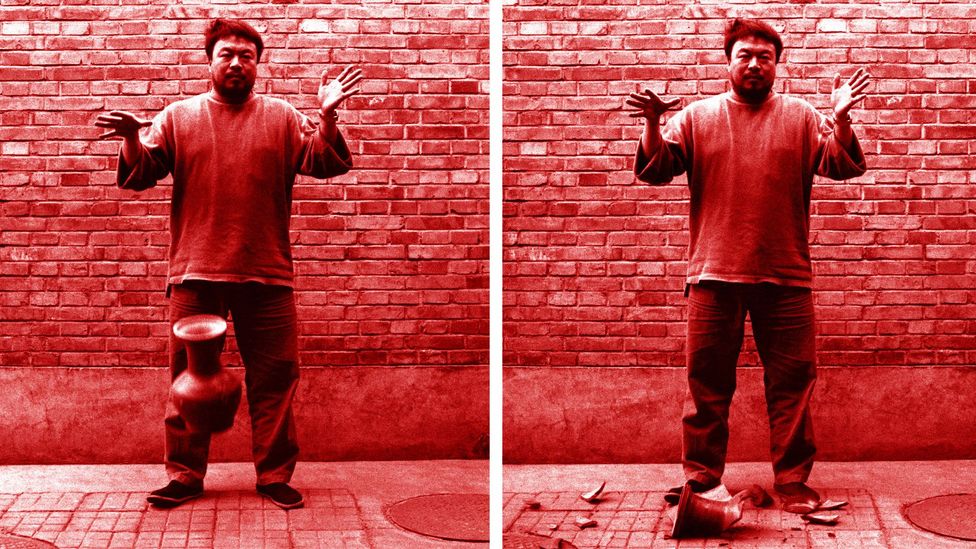
Can obstruction, or outright destruction, exist every bit powerful as the act of creation? Annie Godfrey Larmon takes a look.
P
Popular history has it that the word demolition, from the French sabot, or wooden shoe, was first used in the early 20th Century to describe the labour strike strategy of throwing 1's clogs into machinery to finish upwards product.
Simply the give-and-take in fact derives from the human action of stomping, disruptively, during official speeches. Both origin stories cistron into the discussion's electric current use – these are strategies for obstructing systems of power, whether they are economic flows, political events or military operations. This year, the New Museum in New York opened its fourth Triennial, titled Songs for Sabotage, with works by 30-odd artists and collectives from 19 countries that the prove'south curators claim set up out to "reveal the built systems that construct our reality, images, and truths" with a "phone call for activity, an active engagement, and an interference in political and social structures." But rather than the documentary images, organisational meetings, and workshops ane might expect from such a hope, the show was heavy with paintings and sculptures. Presumably, these works of visual fine art are, in fact, the songs of the exhibition's championship. Of course, propaganda, allegories, and calls to action are non themselves activity, and fine art that represents alter or resistance does not necessarily affect alter or resistance.
- Saddam'due south 'Disney for a autocrat'
- The fine art hidden from Nazi bombs
- Dazzling art from a degenerate dynasty
This brings up a problem that oft arises in conversations about art: how can it participate in networks of ability that its content willfully rejects? Oftentimes, and then-called 'political art' simply aestheticises protest or resistance. Sometimes, it has the effect of moral licensing – instilling in its viewer a fake sense of having accomplished something. Fine art and power take always been begrudging bedfellows. Afterward all, Karl Marx and Friedrich Engels wrote The Communist Manifesto from the comfort of La Maison du Cygne, a gilded restaurant in Brussels.
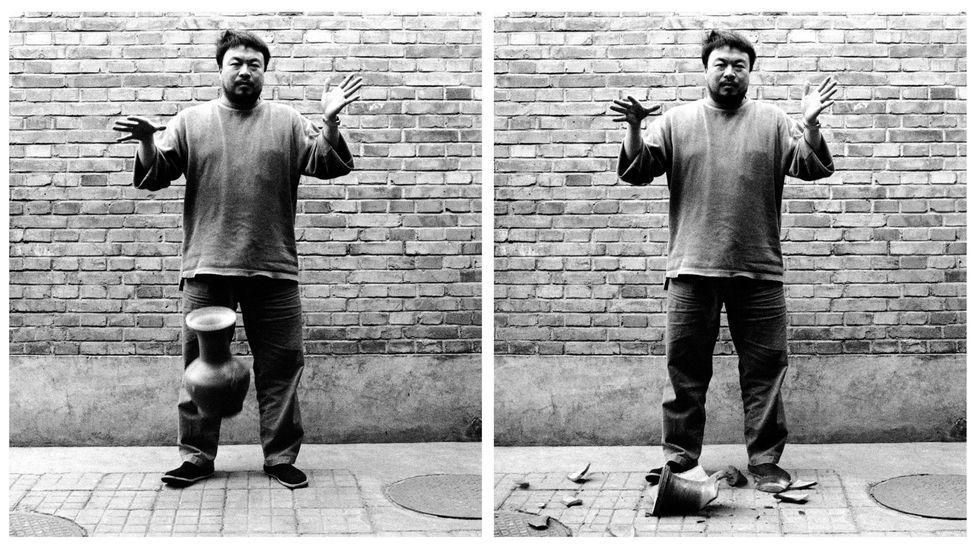
Ai Weiwei dropped a ii,000-yr-old Han dynasty vase for a photograph in 1995 – and he has painted others, arguably an human action of vandalism (Credit: Ai Weiwei)
Allow's consider a brief history of sabotage in the fine art world – in what means accept artists reckoned with the thought that the near powerful acts of creation might be those of destruction? And moreover, if it is possible for artworks themselves to really interfere in political and social structures, what does that disruption wait like? Of course, demolition isn't only about breaking things. Demolition is breaking things then that something else, something different, tin happen.
Appetite for devastation
In terms of destroying fine art itself, 1 might recollect of Gustave Courbet's successful proposal, in 1871, to topple and disassemble the Vendôme column during the events of the Paris District, a monument he claimed was "devoid of all creative value, disposed to perpetuate past its expression the ideas of war and conquest of the past imperial dynasty." Or more than recently, of British artist Hannah Black's chat-fueling but unsuccessful 2017 open alphabetic character requesting that Dana Schutz's painting Open Casket, which reproduced the famous image of Emmett Till at his funeral, be removed from the Whitney Biennial and destroyed. Both of these cases, however, are gestures of framing. The proposals to topple the column and ruin the painting are not artworks in themselves.
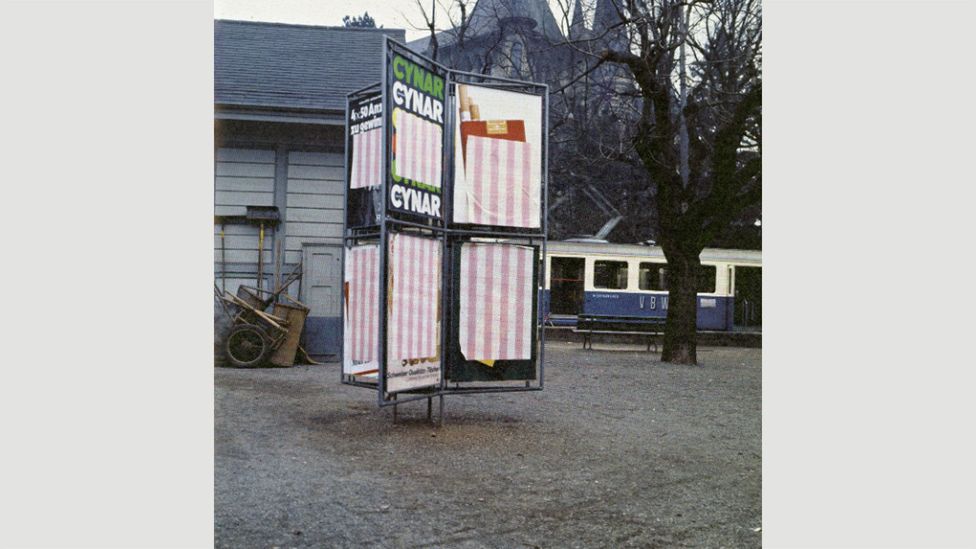
Daniel Buren covered Bern in posters when he was not invited to an exhibition (Credit: Photos-souvenirs: Daniel Buren, March 1969, Bern. Détails. © DB-ADAGP Paris)
By contrast, in 1995, the Chinese artist Ai Weiwei did indeed make an artwork, Dropping a Han Dynasty Urn, past destroying another artwork. His performance is represented in three blackness-and-white photos: the artist holds the 2,000-year-one-time-formalism vase, information technology is defenseless in mid-air, it shatters on the floor. By smashing the urn, Weiwei ruins the budgetary value of the ancient object, but also its cultural value. And on a symbolic level, the activeness represents a rejection of the legacies of the Han dynasty (206 BCE–220 CE), a defining menses in Chinese history. In this way, he provokes the viewer to consider who determines cultural and monetary values alike. But this all plays out merely on the level of representation: no political or social system is impeded.
Efforts of art world demolition are often directed, instead, at the institutions that support art, reflecting artists' frustrations with problems of visibility and accessibility. We might trace this to the 1863 Salon des Refusés, when Courbet, Édouard Manet, James McNeill Whistler and others rejected from the Paris Salon displayed their work, under the auspices of Emperor Napoleon III, in another venue at the Palace of Manufacture.
A century later, in 1969, Daniel Buren was excluded from the famous exhibition When Attitudes Become Course in Bern, and in response he covered the city'due south billboards with his stripes, effectively inserting himself into the show. He was arrested for this action and had to go out Switzerland. Five years subsequently, the United states artist Lynda Benglis responded to misogyny in the art world by paying $three,000 (£ii,118) for an advert in Artforum, in which the artist promoted her upcoming exhibition at Paula Cooper Gallery in New York by posing naked with a big latex dildo.
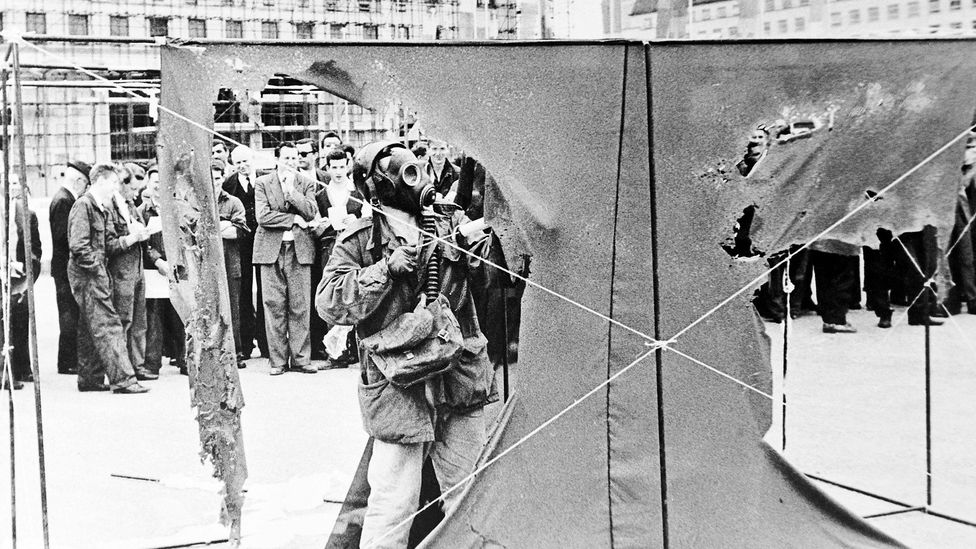
Gustav Metzger created his Auto-Destructive Art by spraying hydrochloric acid on sheets of nylon then standing by as they dissolved over 20 minutes (Credit: Getty Images)
Strategies of withdrawal and refusal have likewise been a manner of art globe sabotage. In 1969, the Art Workers Coalition formed, with such artists as Lucy Lippard and Carl Andre at the helm, organising anti-war protests and urging major institutions to close in opposition to the Vietnam War. Their deportment were in dialogue with other artist-led organisations at the time, such as Women Students and Artists for Black Fine art Liberation, directed by Faith Ringgold, and the Ad Hoc Women Artists group, led by Lippard, whose protests resulted in the inclusion of black women artists in the following Whitney Biennial. In 1974, German language artist Gustav Metzger attacked the commodification of art through such artworks as The Years Without Fine art – 1977-1980, which called for a iii-year hiatus on all fine art product, soapbox, and sales, though his recruitment process was ill-fated.
Issues in the system
Still other demolition-like methods galvanise viewers to take action. In a 1968 performance, Argentine creative person Graciela Carnevale gathered participants in a glass-fronted gallery in Rosario, Argentina earlier leaving and locking the door behind her. She hoped to incite "exemplary violence" in the viewers, who were eventually freed by a passerby who shattered the gallery door. Tania Bruguera, in 2009, performed Self-Sabotage at Paris'southward Jeu de Paume: betwixt readings of her reflections on political art, she took a revolver with a single bullet in its drum, pointed it at her temple, and hazarded the results of Russian roulette. Her action challenged the very efficacy of art to affect reality.
Attempts to fuse art and life full stop have historically been panned by critics – as when the 1993 Whitney Biennial included plumber George Holliday'due south dwelling video of Los Angeles police officers chirapsia Rodney Rex, or when curator Artur Żmijewski invited Occupy Wall Street protesters simply to take over an entire floor of the 7th Berlin Biennale in 2012.
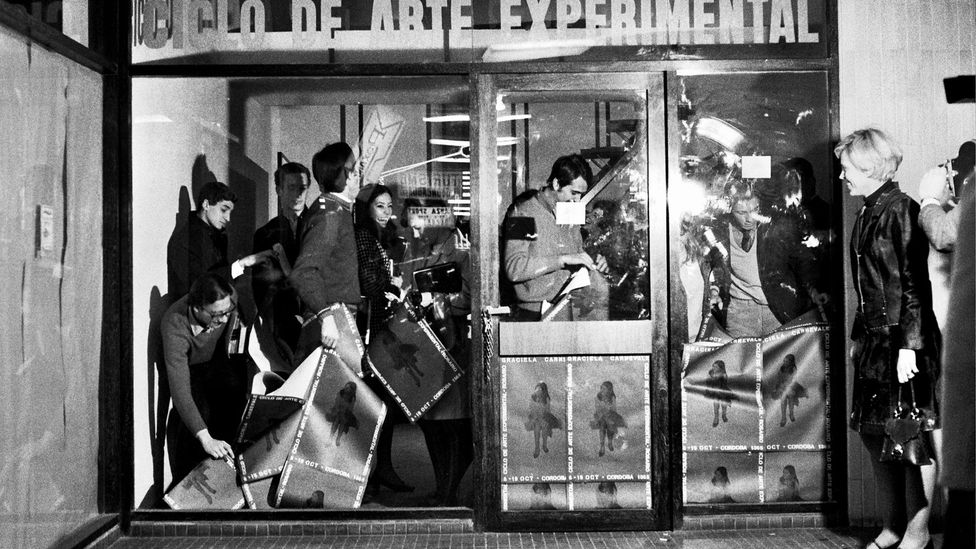
Graciela Carnevale locked attendees at a glass-fronted gallery as an experiment to meet how long before they'd turn to violence (Credit: Graciela Carnevale/Spai Visor)
These projects sabotage the very concept of what an artwork can and should exist. But to return to the opening question: what artworks actually exercise serve to interfere with political and social structures? Hard-pressed, I can think of only a handful that supersede the fraught dynamics of fine art, life, and power to intervene in systems while maintaining rigor in form or concept – works of art that actually do have purpose and upshot on the existent world.
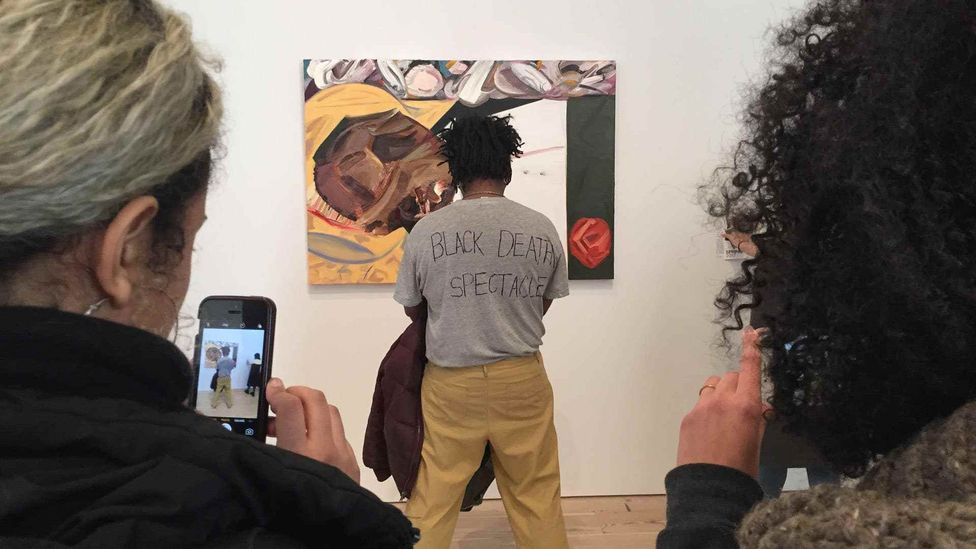
Artist Parker Vivid protested Dana Schutz'southward stylised take on United states lynching victim Emmett Till past obstructing view of it (Credit: Twitter/User does not wish to be identified)
In 1997, the German creative person Christoph Schlingensief pulled off one such work when he organised Tötet Helmut Kohl! (Kill Helmut Kohl!), for which he gathered equally many unemployed people every bit possible to swim in and so-German chancellor Helmut Kohl's favourite holiday destination, the Austrian Wolfgangsee, while the politician was on vacation. He claimed that all of Federal republic of germany's unemployed would together displace the lake's h2o. In 2014, Lawrence Abu Hamdan fabricated the work The All-Hearing, for which he asked two sheikhs in Cairo not to evangelize their usual weekly Friday sermons, but instead to deliver city-wide speeches well-nigh the dangers of dissonance pollution equally a public health issue. Schlingensief and Abu Hamdan alike disrupted a condition quo to force a change.
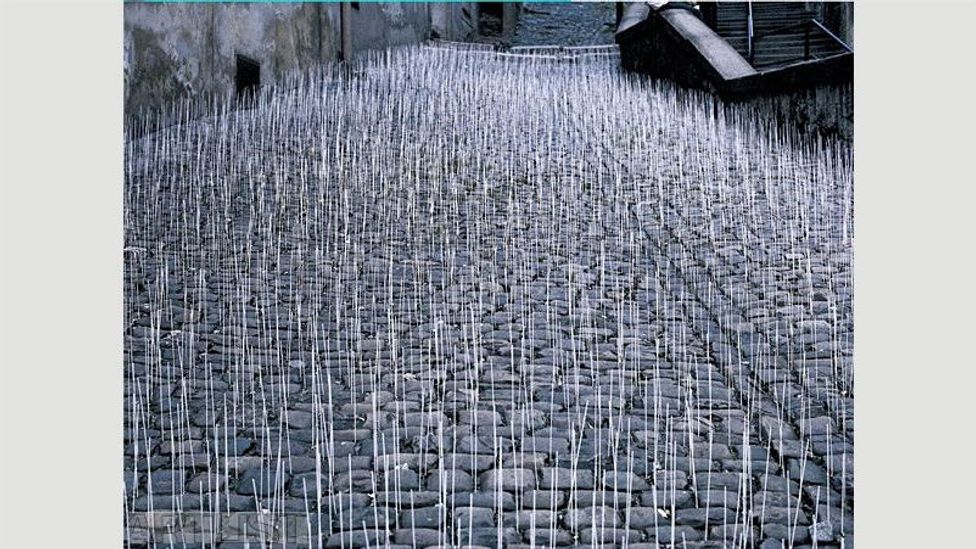
In 1981 Ivan Kafka covered a street in Prague with ane,000 upright wooden sticks – the only style people could become to work was by trampling them (Credit: Ivan Kafka/Artlist.cz)
Of course, sabotage is mischievous. Frequently, information technology is an intervention that begins as a pocket-size interference that multiplies or magnifies to effect in the destruction of a arrangement. And often, information technology is perpetrated anonymously. This relationship to duration and authorlessness alone makes true sabotage an irksome chore for artists. That said, my favourite act of artistic sabotage was perpetrated in 1981, in the quiet of the night, by Czech creative person Ivan Kafka. Overnight, in the cobblestones of Jansky Street in Prague'southward Neruda district, just below the castle that serves as the historical and symbolic caput of the Czech authorities, Kafka bundled 1,000 wooden sticks that stood upright. When local residents opened their doors to leave for work in the morning, they were faced with the decision to trample the work – and so an illegal deed of complimentary expression – or to preserve it and fail to appear for their jobs. Kafka'southward installation brings to heed a line from scholars Fabio Rambelli and Eric Reinders: "Devastation is not the end of culture but one of the atmospheric condition of its possibility."
If you would like to comment on this story or anything else you have seen on BBC Culture, head over to our Facebook page or message the states on Twitter .
And if you liked this story, sign up for the weekly bbc.com features newsletter , called "If You lot Only Read six Things This Calendar week". A handpicked selection of stories from BBC Future, Civilization, Upper-case letter and Travel, delivered to your inbox every Friday.
Source: https://www.bbc.com/culture/article/20180517-can-art-change-the-world
Post a Comment for "Can a Work of Art Change the World Can Works of Art Change Lives"